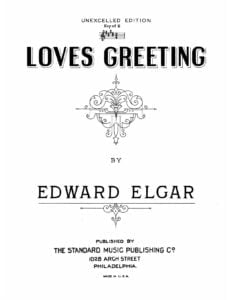Browse in the Library:
Or browse in the categories menus & download the Library Catalog PDF:
Edward ELGAR – SALUT D’AMOUR Op. 12 (LOVE GREETINGS) Piano solo arr. with sheet music download.

Edward Elgar – Salut d’Amour
Salut d’Amour, Op. 12 is a musical work composed by Edward Elgar in 1888, originally written for violin and piano.
Elgar completed the piece in 1888, when he was engaged to marry Caroline Alice Roberts, and called the work ‘Liebesgruss’ (‘Love’s Greeting’) because of Alice’s fluency with German. When he returned to London on September 22 of that same year to spend his holidays at his friend Charles Buck’s house in Settle, he showed Alice his work as an engagement present. She, for her part, offered him a poem called ‘The Wind at Dawn’, note 1 which he had written years before and which he soon set to music in 1888.
The dedication was in French: ‘à Carice.’ ‘Carice’ was a combination of the names of his wife, Caroline Alice, and was the name given to his daughter, born two years later.
It was published by Schott & Co. a year later and the first editions were for violin and piano, solo piano, cello and piano, and for small orchestra. Few copies were sold until the publisher changed the title to Salut d’Amour, leaving ‘Liebesgruss’ as the subtitle, and the composer’s name as ‘Ed. Elgar.’ Elgar realized that the French title would help the work to be sold not only in France but in other European countries: Schott was a German publisher with offices in Mainz, London, Paris and Brussels.
Towards the end of 1888, Edward submitted three arrangements of the work – for solo piano, for violin and piano, and an orchestral arrangement – to the music publishing firm of Schott who agreed to buy the work outright for a fee of two guineas. At first, the work sold slowly. Apparently with Elgar’s approval, Schott’s retitled the work Salut d’Amour and gave the composer’s name as Ed. Elgar, believing that the French title and a less obviously English composer would help the work gain wider international approval. It did, much to the publisher’s satisfaction but with no financial benefit to Elgar.
It is easy to dismiss Salut d’Amour as an insignificant trifle, salon music not deserving a wider audience. However, for the work to establish itself so forcefully in what was a fiercely competitive field says much for its charm and quality. And, as Elgar’s first published work, it has a historical value, containing pointers to the skills that Elgar was to develop and display in his later works.
Elgar subsequently composed a companion piece, Mot d’Amour (Liebesahnung or Love’s Word). Although in many ways structurally and dramatically superior to the earlier work, it failed to capture the public affection of its predecessor and is rarely heard today.
The first public performance of the work was in its orchestral version and took place in a concert at The Crystal Palace on November 11, 1889, conducted by August Manns.
List of compositions by Edward Elgar

Browse in the Library:
Or browse in the categories menus & download the Library Catalog PDF:
